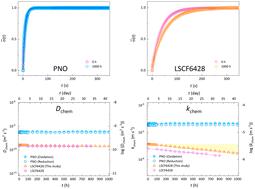当前位置:
X-MOL 学术
›
J. Mater. Chem. A
›
论文详情
Our official English website, www.x-mol.net, welcomes your
feedback! (Note: you will need to create a separate account there.)
Enhanced oxygen exchange kinetics and long-term stability of a Ruddlesden–Popper phase Pr4Ni3O10+δ cathode for solid oxide fuel cells
Journal of Materials Chemistry A ( IF 10.7 ) Pub Date : 2024-11-12 , DOI: 10.1039/d4ta01845a Saim Saher, Affaq Qamar, Chou Yong Tan, S. Ramesh, Walied Alfraidi
Journal of Materials Chemistry A ( IF 10.7 ) Pub Date : 2024-11-12 , DOI: 10.1039/d4ta01845a Saim Saher, Affaq Qamar, Chou Yong Tan, S. Ramesh, Walied Alfraidi

|
This research explores the intricacies of oxygen exchange kinetics in Pr4Ni3O10+δ (PNO), aiming to assess its potential as a viable cathode material for solid oxide fuel cell applications. Utilizing a multifaceted approach, advanced techniques such as electrical conductivity relaxation, pulse isotopic exchange, and oxygen permeation are employed. A comparative analysis with other promising cathode materials, specifically La0.6Sr0.4Co0.2Fe0.8O3−δ (LSCF6428), reveals PNO superior performance. At 650 °C, PNO exhibits a chemical diffusion exchange coefficient, Dchem, and surface exchange coefficient, kchem, that are an order of magnitude higher than those of LSCF6428. Long-term stability assessment through 1000-h electrical conductivity relaxation testing at 700 °C confirms PNO consistent performance. Oxygen permeation studies reveal an inverse correlation between membrane thickness and the permeation rate. Notably, PNO demonstrates an impressive two-fold higher oxygen flux compared to LSCF6428. Furthermore, PNO maintains stable oxygen permeation over 1000 h at 700 °C, contrasting with an observed 11% degradation in LSCF6428. X-ray diffraction and scanning electron microscopy analyses corroborate PNO stability, while secondary phase formation observed in LSCF6428 contributes to its degradation. The pulse isotopic exchange measurements conducted on the fractionated powder of PNO within the temperature range of 350–450 °C provide valuable insights into the surface exchange mechanism. These measurements reveal that at the highest oxygen partial pressure (pO2) values covered by the experiments, the relative rates of dissociative adsorption, ℜads, and oxygen incorporation, ℜinc, engage in competitive oxygen exchange dynamics. Conversely, at lower pO2 values, oxygen exchange is predominantly limited by ℜads.
中文翻译:

用于固体氧化物燃料电池的 Ruddlesden-Popper 相 Pr4Ni3O10+δ 阴极的增强氧交换动力学和长期稳定性
本研究探讨了 Pr4Ni3O10+δ (PNO) 中氧交换动力学的复杂性,旨在评估其作为固体氧化物燃料电池应用的可行阴极材料的潜力。利用多方面的方法,采用了先进的技术,例如电导率弛豫、脉冲同位素交换和氧渗透。与其他有前途的正极材料,特别是 La0.6Sr0.4Co0.2Fe0.8O3−δ (LSCF6428) 的比较分析表明 PNO 具有优异的性能。在 650 °C 时,PNO 的化学扩散交换系数 Dchem 和表面交换系数 kchem 比 LSCF6428 高一个数量级。通过在 700 °C 下进行 1000 小时的电导率松弛测试进行长期稳定性评估,确认 PNO 的性能一致。氧渗透研究揭示了膜厚度和渗透速率之间的负相关关系。值得注意的是,与 LSCF6428 相比,PNO 的氧通量高出两倍,令人印象深刻。此外,PNO 在 700 °C 下保持稳定的氧渗透超过 1000 小时,而观察到的 LSCF6428 降解为 11%。X 射线衍射和扫描电子显微镜分析证实了 PNO 的稳定性,而在 LSCF6428 中观察到的二次相形成有助于其降解。 在 350–450 °C 的温度范围内对 PNO 的分馏粉末进行的脉冲同位素交换测量为表面交换机制提供了有价值的见解。这些测量表明,在实验涵盖的最高氧分压 (pO2) 值下,解离吸附的相对速率 Rads 和氧掺入 Rinc 参与竞争性氧交换动力学。相反,在较低的 pO2 值下,氧交换主要受 R广告的限制。
更新日期:2024-11-12
中文翻译:

用于固体氧化物燃料电池的 Ruddlesden-Popper 相 Pr4Ni3O10+δ 阴极的增强氧交换动力学和长期稳定性
本研究探讨了 Pr4Ni3O10+δ (PNO) 中氧交换动力学的复杂性,旨在评估其作为固体氧化物燃料电池应用的可行阴极材料的潜力。利用多方面的方法,采用了先进的技术,例如电导率弛豫、脉冲同位素交换和氧渗透。与其他有前途的正极材料,特别是 La0.6Sr0.4Co0.2Fe0.8O3−δ (LSCF6428) 的比较分析表明 PNO 具有优异的性能。在 650 °C 时,PNO 的化学扩散交换系数 Dchem 和表面交换系数 kchem 比 LSCF6428 高一个数量级。通过在 700 °C 下进行 1000 小时的电导率松弛测试进行长期稳定性评估,确认 PNO 的性能一致。氧渗透研究揭示了膜厚度和渗透速率之间的负相关关系。值得注意的是,与 LSCF6428 相比,PNO 的氧通量高出两倍,令人印象深刻。此外,PNO 在 700 °C 下保持稳定的氧渗透超过 1000 小时,而观察到的 LSCF6428 降解为 11%。X 射线衍射和扫描电子显微镜分析证实了 PNO 的稳定性,而在 LSCF6428 中观察到的二次相形成有助于其降解。 在 350–450 °C 的温度范围内对 PNO 的分馏粉末进行的脉冲同位素交换测量为表面交换机制提供了有价值的见解。这些测量表明,在实验涵盖的最高氧分压 (pO2) 值下,解离吸附的相对速率 Rads 和氧掺入 Rinc 参与竞争性氧交换动力学。相反,在较低的 pO2 值下,氧交换主要受 R广告的限制。


















































 京公网安备 11010802027423号
京公网安备 11010802027423号